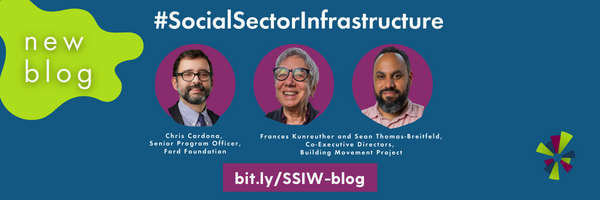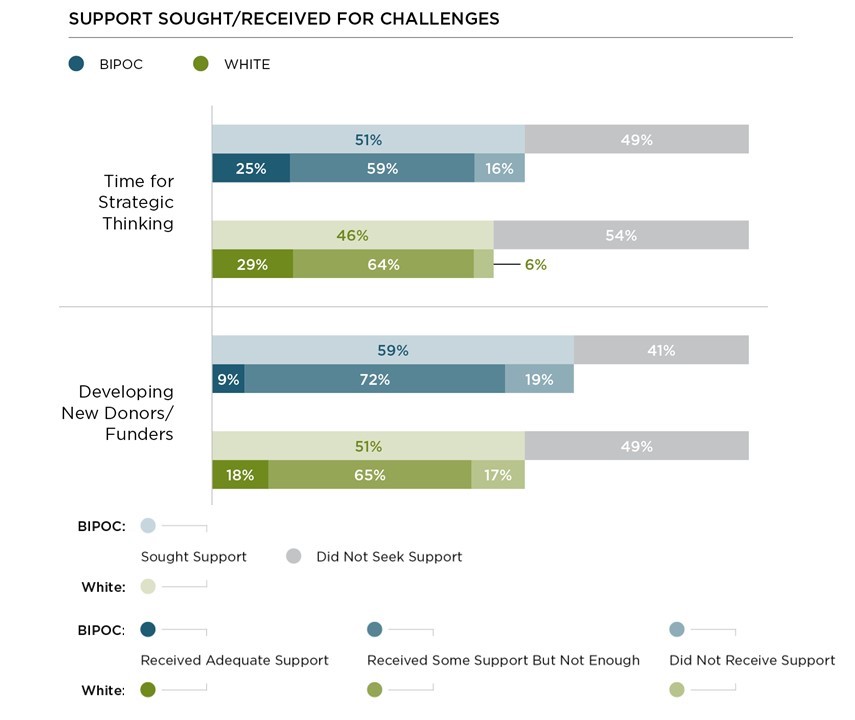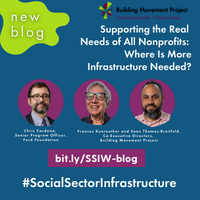Feb
28
2023
Chris Cardona, Frances Kunreuther, Sean Thomas-Breitfeld

The social sector provides vital services, connection, and advocacy in the U.S. and around the globe. Nonprofits represents more than 10% of the U.S. private workforce, and are a leading employer in many parts of the country. Running a nonprofit often means addressing some of the most difficult and long-standing issues facing our society while making sure there are the funds and skills needed to keep the organization afloat. So, it is no surprise that nonprofit organizations need support.
In a series of new reports on social sector infrastructure, the Urban Institute and George Mason University identified four key functions that the social sector needs to operate effectively: sustainability, learning, relationships, and influence. This week, they released their report on infrastructure providers that offer services to social sector organizations.
The Urban Institute’s findings resonate with a report recently released by the Building Movement Project (BMP) that looked at infrastructure needs of nonprofit groups, especially small community based organizations that make up the majority of the sector. Working with partner organizations in Massachusetts, New Mexico, North Carolina, Oregon, Tennessee, Texas, and Wisconsin, BMP surveyed over 800 nonprofit leaders. The majority of respondents worked in local communities and led nonprofits with annual budgets of under $1 million. The survey asked leaders about their organizations’ infrastructure needs, whether or not they had received support for these needs, the barriers they faced in finding support, and the top recommendations for infrastructure providers and funders.
The BMP report, Meeting the Need: Building the Capacity of Community Based Organizationsfound that the leaders of local nonprofits wanted support in a variety of areas, especially growing their organizations, raising money, and addressing staff issues like burnout. Contrary to assumptions that organizations led by people of color have more capacity needs, there was little difference between BIPOC and white leaders in their responses, except for issues related to diversity, equity and inclusion, where white-led nonprofits had more capacity needs.
The Urban/GMU findings, The State and Future of the National Social Sector Infrastructure (along with reports on the financing and potential strengthening of the infrastructure), emphasize some of the barriers facing infrastructure supporting organizations, including the funding challenges for intermediary groups serving nonprofit organizations compared to those supporting philanthropy. This parallels findings in BMP’s Meeting the Need report.
While survey respondents reported that the biggest barrier to accessing support was a lack of time, the second highest-ranked barrier was “finding providers that we can afford.” As shown in the figure below, another challenge faced by nonprofit leaders was finding adequate support for the challenges they face. For instance, when faced with fundraising challenges, a larger share of BIPOC leaders sought support, but were less likely than white leaders to feel that the support they received was adequate. Many respondents wrote in open-ended questions about the need for infrastructure providers to understand the specific challenges of the organization. This was confirmed by a survey question about barriers leaders faced in obtaining the help they needed. BIPOC leaders reported more difficulty than white leaders in finding providers who understood the needs of the communities they served.
One final note from Meeting the Need. In focus groups and hundreds of write-in responses, it was clear that funding remained a top concern for community based organizations. Capacity building without operational support often led to frustration for leaders who were offered valuable advice but had few resources to implement any needed change.

As a funder reading these findings, I (Chris) find this last point especially important. Are we funders using capacity-building support as a substitute for what organizations really need, that is, multi-year, flexible support? Is it a disservice to provide capacity-building funds without operating capital to implement them? That’s why I appreciate that BUILD grants from the Ford Foundation, where I work, are a combination of flexible support and capacity-building funds, what we call targeted support for institutional strengthening. Nonprofits need both kinds of funding, or as my colleague Victoria Dunning puts it, fuel for the tank and maintenance for the car. Furthermore, are we as funders treating BIPOC-led organizations unfairly by assuming, without asking, that they have different capacity needs than other organizations? These findings make me think twice about how I approach capacity-building support. It’s vital, but needs to be provided in a holistic and informed manner.
Call to Action
Given the findings from both the Urban/GMU and the Building Movement Project reports on infrastructure, we believe there are important areas for improvement across the social sector that can be implemented by funders and nonprofit-support organizations. Below we outline recommendations for how those in the sector with the most resources and power can support nonprofits on the ground.
Funders are crucial in their support for nonprofits to develop and grow. We recommend:
- Lifting up examples of how local funders have offered infrastructure support in addition to, not instead of, general operating support.
- Sharing information with nonprofits on best practices for finding and vetting capacity builders, especially to help groups assess whether infrastructure providers understand the needs of BIPOC-led (and focused) organizations.
- Supporting local infrastructure and intermediary groups that can reach community based organizations.
- Using investments in philanthropy-serving organizations to build and strengthen community based nonprofits.
Infrastructure providers are the linchpin for providing capacity building support. We recommend:
- Increasing their emphasis on and support for the work of smaller, grassroots nonprofits, taking time to understand the unique (and common) needs of the organization.
- Hiring and supporting more consultants of color that are familiar with the needs of local BIPOC communities and who can support BIPOC leadership.
- Soliciting and changing practices based on feedback from community based groups to ensure that the supports nonprofits receive are adequate and meet the real needs of organizations.
Chris Cardona is senior program officer, philanthropy, at the Ford Foundation, which supported the Meeting the Need scan. Frances Kunreuther and Sean Thomas-Breitfeld are Co-ED’s of Building Movement Project. Cardona and Kunreuther served on the advisory board of the Urban/GMP scan.

